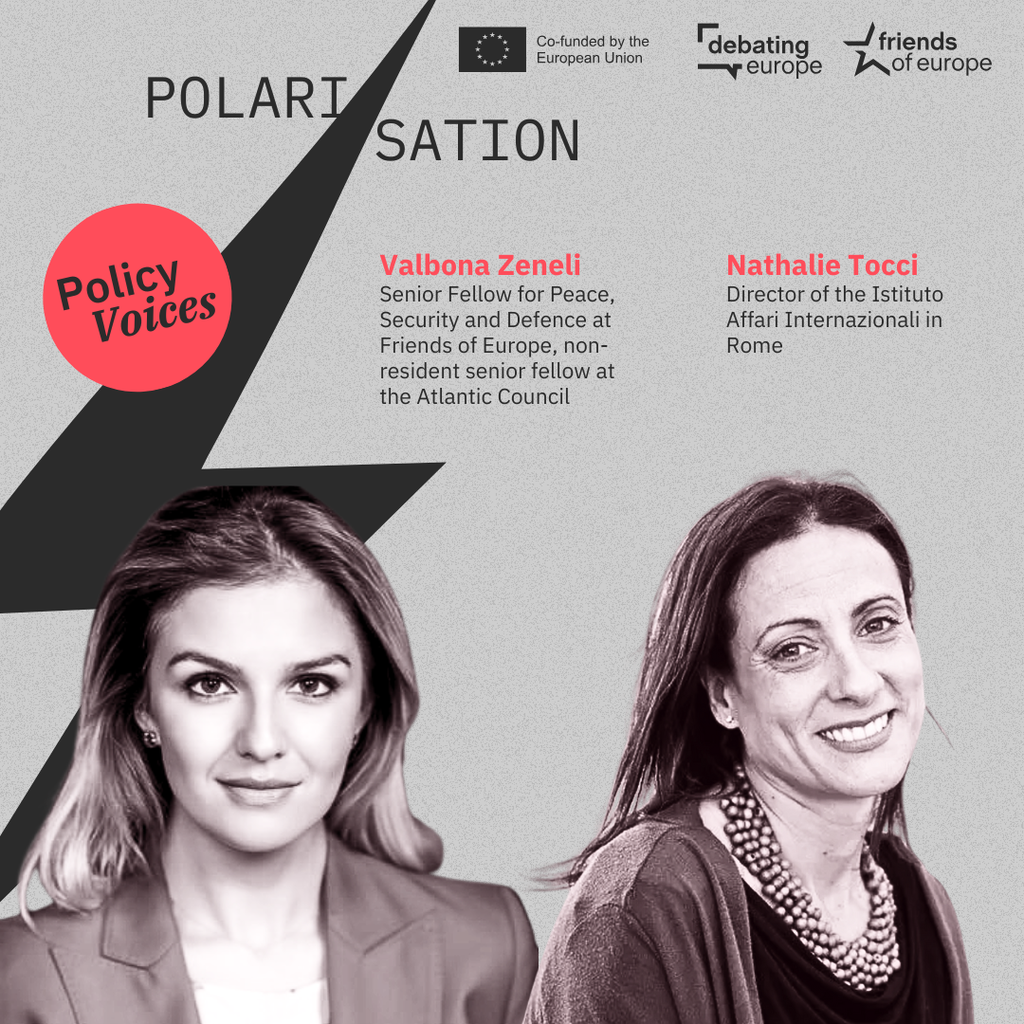From ambition to action: building Europe’s Defence Union
Past event In person

- Area of Expertise
- Peace, Security & Defence
Peace, Security & Defence

Senior Fellow for Peace, Security and Defence at Friends of Europe, and former Deputy Assistant Secretary General for Emerging Security Challenges at the North Atlantic Treaty Organization (NATO)
Over the past few years we have been much preoccupied with the notion of resilience. Hardly a security conference in North America or Europe has passed without devoting at least one keynote speech or panel to this topic. It all kicked off after the 9/11 terrorist attacks when we had to cope with potential threats to our airlines and the ramping up of security checks at our airports and stations that followed. Rather than bunker down in self-imposed quarantine the imperative at that time was to go shopping or to book weekend breaks in order to deprive the jihadists of the satisfaction of depressing our economies as well as killing our fellow citizens.
Then came the first great wave of cyber-attacks and the compromise of our information technology and personal and corporate data. In response we have had to establish standards for cybersecurity, devise new forms of insurance to cope with data breaches and elaborate new risk management models to focus our firewalls on our most important assets. We have also had to think hard about how much of our personal lives and privacy we really want to share online.
As relations with Russia deteriorated in the wake of Putin’s incursions into Ukraine in 2014, hybrid warfare became the new concern. We turned to the vulnerabilities of our critical infrastructure, to the ways in which targeted disinformation and fake news circulating on social media could be used to interfere in our political debates and election campaigns, and to our ability to recover quickly from deliberate provocations such as the use of the Novichok nerve agent by Russian intelligence operatives in Salisbury. Most recently climate change has been the focus of resilience as we have seen the need to improve our flood defences, get our transport networks back up and running after violent storms or put out forest fires during the hottest summers on record.
All these developments have obliged us to rethink resilience. This has meant going back to Cold War practices of civil preparedness and civil emergency planning. Governments and security organisations like NATO have revived Cold War baseline requirements to cope with major conflict and mass casualties. Things like business continuity planning in government, secure communications and transport links, adequacy of food and water supplies and the ability to surge medical treatment facilities have all been extensively reviewed. Reporting and assessment mechanisms used during the Cold War have been revived.
The initial findings have not been especially encouraging. After decades of post-Cold War peace in Europe, governments have not stocked the necessary food, fuel and medical supplies. There is an over-reliance on fragile globalised and just-in-time delivery supply chains and much of our critical infrastructure (such as railways, ports, airports and communications and power lines) has been privatised. Today, for instance, NATO relies on the private sector to move 90% of its equipment and to provide 75% of its in-country support.
Immediate mass testing is key because it allows governments to have a reliable idea of the true number of people who are infected and where
At the same time, both NATO and the EU have been striving to improve the resilience of their member states against the new security challenges. Intelligence services have been beefed up to detect hybrid warfare activity earlier, to speed up reliable attribution, to hold exercises on cyber defence and to work with the private sector to share information on attacks. Both the EU and NATO have set up rapid response teams and lists of experts to be deployed to member states to help with the mitigation of cyber-attacks and critical infrastructure disruptions. The EU has established task forces to spot fake news and NATO has looked at improving the detection of biological and chemical agents and CBRN decontamination units in the wake of the Salisbury Novichok attack. In short, resilience was something that we thought we now understood and were beginning to get under control.
But then came the coronavirus and in just a few short weeks it has cruelly revealed just how vulnerable Western democracies still are – and how quickly and totally their economies and lifestyles can be turned upside down. When the virus eventually subsides, we will need to revise our understanding of resilience and the tough choices it will mean for our way of life in the future.
First and foremost, we will need to learn the lessons from those that have handled the coronavirus outbreak relatively well. Take South Korea for instance. Even though the MERS outbreak in 2015 caused only 38 deaths in 186 confirmed cases, South Korea reacted by taking preparations for a future, more deadly outbreak seriously. It stocked testing equipment to immediately test 50,000 people a day as soon as news of the outbreak of COVID-19 in China broke. This meant that rather than lock down the entire country it was able to identify and track individual cases of infection and locate clusters of infection that could be rapidly quarantined. In this way it was able to start to attack and not merely to contain the virus.
Immediate mass testing is key because it allows governments to have a reliable idea of the true number of people who are infected and where, and therefore of the extent of the problem. This is crucial in dealing with a novel pathogen that cannot be seen and has a lengthy incubation period but spreads exponentially. Whereas it took the world 67 days to reach the first 100,000 infected, it took only 2 days to go from 300,000 to 400,000. By contrast, health authorities in northern Italy did not start limited testing until the outbreak was already in the several hundreds, and they have been chasing the curve of infections ever since. Significantly, death rates in South Korea have remained at under 1% of confirmed cases while in Italy they have been running at 10%.
Immediate controls at South Korean airports helped to regulate the flow of people coming in and out of the country. These were critical to prevent the spread of COVID-19 while still keeping the country open for business. This is in marked contrast to the pictures of thousands of people huddled together for hours in US immigration before being allowed to enter the United States.
Do Western democracies need to become more Asian?
The government in Seoul has also made extensive use of information technology to track its population. Tracking apps have geo-located its citizens, and those who have been in contact with infected people or who display symptoms of infection themselves are warned by beeps and text messages to stay at home. This is possible because all South Koreans have a digital ID number. It allows the government to send constant messages and updates to all its citizens. This Big Brother mass surveillance is of course a violation of privacy as the only way to hide is to turn off your iPhone. Numerous extramarital affairs have been unmasked by apps tracking illicit liaisons to “Love Hotels”; but the intrusive use of information technology to generate big health data, enhanced by AI, and to process biometrics on a mass scale allows authorities to track in real-time the evolution of the virus and to take targeted rather than scattergun actions.
Moreover, South Korea (like Belgium) has left its public communications to health experts and officials from its national crisis centre. The politicians have helpfully gotten out of the way. This has meant that accurate, honest and transparent information has dominated the airwaves and social media reinforcing public trust in the government. There is less scope for alternative narratives to gain traction. Compare that to Trump’s news conferences in the United States and millions of Americans reporting on social media that they believe the conspiracy theory that coronavirus is a North Korean biological weapon.
Of course, we are not out of the woods yet and South Korea is still reporting limited numbers of new infections. Its model is based on a Confucian culture of social order and discipline and a highly centralised system of government. Its exploitation of information technology to create a wired society may not be what privacy and freedom-loving Westerners want to see in their societies. Countries like China, which have used draconian social control measures to reduce the rate of infection quickly and restart their economies before depression hits, may soon invoke the spirit of former Singapore prime minister Lee Kuan Yew to claim that the COVID-19 crisis represents the triumph of Asian over Western values. On the defensive because it failed to reveal the nature and extent of the virus early enough, China is accelerating its disinformation campaign to lay the blame for the outbreak on the US or Italy.
Yet as we draw the lessons of the crisis a question will be: do Western democracies need to become more Asian? At least in terms of governments giving themselves wartime powers, suspending parliaments, increasing mass surveillance and commandeering the private sector to produce crisis-related products such as masks, scrubs and respirators. How bad does a crisis need to be before these special powers can be legitimately assumed? Who will guard the guardians and hold governments to account on issues of resource distribution and social fairness? How can we be sure that at the end of the crisis the special powers will be ended rather than surreptitiously retained?
Will others, such as Russia and China, who are less affected by coronavirus or recover from it faster, exploit this vacuum?
What we know is that after the two world wars big government did not return its new power to the people. To better prepare for the next pandemic, how much power should we leave vested in our governments, or should we insist on the return to the status quo ante even if it means taking greater risks in the name of democracy, privacy and freedom? At a minimum, we need to have this debate as much as we will focus inevitably on the number of intensive care beds available in our health services.
Another debate in determining the future of resilience concerns the role of our armed forces. France and the Czech Republic are pulling their armed forces out of the NATO training mission in Iraq. The Pentagon has stopped deploying forces overseas. NATO exercises to uphold collective defence in Europe have been cancelled or scaled back. Our armed forces are now needed urgently at home: to transport the dead for burial, to build army field hospitals or convert concert halls or exhibition centres into medical facilities, to transport the sick for treatment on medical ships or to take over civilian airports to ease crisis logistics, such as at London City airport. France, Spain and Italy are using military drones to track the stay-at-home policy in major cities. Even Germany is relaxing Article 35 of its Basic Law to enable the Bundeswehr to respond to 140 requests for assistance from the Lander.
COVID-19 builds on a pattern that we have already been seeing with the armed forces. In the UK they have built flood defences in Yorkshire and provided security for the London Olympics. Australian forces have been fighting bush fires and lifting beleaguered homeowners off beaches and French and Belgian paratroopers have for many years already been patrolling airports and stations against terrorist attacks. As we experience more seismic resilience shocks our military is being used increasingly at home to support the civilian response agencies.
What will be the future of global order if Western militaries increasingly desert UN peacekeeping operations, capacity-building tasks and counter-terrorism in Africa or the ranks of NATO’s enhanced forward presence in Eastern Europe? What if our armed forces prove as vulnerable to pathogens and epidemics as the general population and have to shut down their activities and go into lockdown? If our militaries now need to focus on domestic resilience and recovery tasks, their high-intensity training, multinational interoperability and war-fighting skills will atrophy.
Will others, such as Russia and China, who are less affected by coronavirus or recover from it faster, exploit this vacuum to project their own influence and steer the course of global security? Can we let this happen without at least having a debate, after the present crisis has subsided, about the future role of our armed forces and whether we really want them to become the default option for our own lack of preparation and resilience?
A challenge will be to make our first responders more resilient than our populations in general if our health services are not to rapidly collapse
At the very least we need to discuss how to make our forces less vulnerable to infections, whether natural or in the form of manufactured biological agents. The current military lockdown is an open invitation to our adversaries to hit us with pathogens rather than missiles.
Finally, resilience is not just about foresight and preparation. It is also about moving forward and backing up where and when needed. Governments have asked retired doctors and nurses to return to duty. The UK government has appealed for 250,000 volunteers to support the National Health Service and deliver vital food and medicines to isolated pensioners. 405,000 responded within 24 hours. The COVID-19 crisis has shown how quickly our frontline services can be overwhelmed by exhaustion or illness once infections spike. Currently, 14% of the deaths in Spain have been among health workers. Over 5,000 health workers have been infected and even if they do not become seriously ill, they have to leave work and spend weeks in self-isolation.
So, a challenge will be to make our first responders more resilient than our populations in general if our health services are not to rapidly collapse, leading to an exponential increase in death rates as patients are not identified and treated. Again, the greater mobilisation of our societies into a form of home army or voluntary reserve builds on trends that we have been witnessing. Estonia has formed a citizens Cyber Defence League to help the government respond to cyber-attacks on critical infrastructure. Conscription has been reintroduced in Sweden and Lithuania. Resilience education is now part of the school curriculum throughout Scandinavia and Italy. In the wake of the coronavirus crisis, look out for the inevitable debate on the lessons learned from citizen mobilisation and how this can be trained and organised to support the first responders in the future.
What is clear is that COVID-19 is transforming our understanding of resilience. It has shifted away from our ability to cope with a short-term and localised disruption – no matter how dramatic at the time – and towards our capacity to switch from a globalised to an autarkic social and economic system, and then back again, in a matter of weeks. In short, resilience is now about running one type of country while holding the other one permanently in reserve. And living temporarily with authoritarianism without losing our democracy through repeated suspensions as each new pandemic or other type of shock hits us. It will be a massive challenge and we need a mature objective debate, not driven by false populist conclusions or emotional, knee jerk reactions. As T. S. Eliot once wrote, “We had the experience but missed the meaning.”
Past event In person

Next event In person & Livestreamed

Past event Online

Past event Online





Stay informed
We use cookies and similar technologies to adjust your preferences, analyze traffic and measure the effectiveness of our campaigns. Learn more about our privacy policy.